Comprehensive Insights on Whitefly Repellents and Efficacy
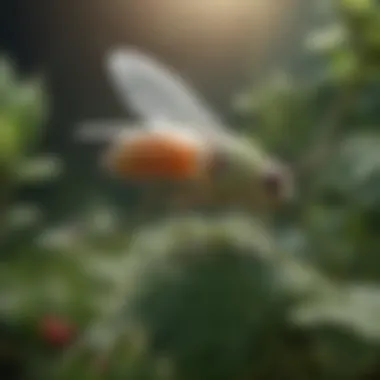

Intro
Whiteflies are more than just a nuisance in gardens and agricultural fields; they can be devastating to crops. These tiny insects suck sap from plants, leading to weakened growth and even plant death. To combat this menace, a plethora of whitefly repellents exist. Understanding these options is critical not only for farmers and horticulturists but also for those interested in sustainable gardening practices.
In recent years, there's been considerable discussion about what makes a repellent effective. Some lean on natural ingredients, which often harmonize with the environment, while others utilize synthetic chemicals that promise swift results. Knowing the strengths and weaknesses of each method can empower users to make informed decisions that align with their ecological values and agricultural needs.
Moreover, the science behind the action of these repellents reveals a fascinating interplay of natural processes and chemical interactions. Drawing from research findings, this article aims to dissect these layers and give a well-rounded perspective on whitefly repellents.
Research Overview
Summary of Key Findings
The research conducted on whitefly repellents indicates a rising trend towards the use of more sustainable and environmentally friendly options. Here are some notable insights:
- Studies show that botanical repellents, such as those derived from neem oil and garlic, have shown promising results in reducing whitefly populations without harming beneficial insects.
- Synthetic options, while effective, have raised concerns about resistance development in whiteflies and potential negative impacts on non-target species in the ecosystem.
- Integrated Pest Management (IPM) strategies combining various types of repellents have yielded the best overall results.
Importance of the Research
This exploration is crucial not only for improving crop yield but also for promoting sustainable agricultural practices. Understanding the effectiveness and ecological impact of various repellents can guide farmers and gardeners in their practices, ultimately leading to healthier plants and ecosystems. It sheds light on how innovations in the field can directly affect agricultural productivity and environmental conservation, making it relevant across a broad spectrum of stakeholders.
Methodology
Study Design
The studies performed typically involve both field trials and controlled laboratory settings. This dual approach allows researchers to evaluate how different repellents perform under natural conditions versus controlled variables. A mixed-method approach can clarify inconsistencies found in purely laboratory studies and provide a more comprehensive view of efficacy.
Data Collection Techniques
Data collection often involves:
- Monitoring whitefly population levels before and after the application of repellents.
- Assessing the health and biomass of treated plants in comparison to untreated controls.
- Observing non-target species to determine any ecological impacts.
In summarizing these techniques, researchers can finely tune their findings and formulate recommendations that consider both agricultural efficacy and environmental stewardship.
"Effective whitefly control requires a balance of efficacy and ecological health to preserve the broader ecosystem."
Understanding Whiteflies
Whiteflies, albeit small in size, have garnered significant attention due to their robust impact on agriculture. These pests are not just a nuisance; they can severely affect crop yields and the health of various plants. By comprehending the intricacies of whiteflies, including their biological classification, life cycles, and the consequences of their presence, farmers and researchers can develop more effective control strategies.
Understanding whiteflies involves a deeper look into their behavior and life stages. It helps in identifying the precise moments when they are most vulnerable, allowing for strategic applications of repellents. Moreover, recognizing the damage caused by whiteflies can lead to greater awareness of the need for appropriate pest management techniques in agricultural practices.
There are several important aspects to consider when exploring the menace of whiteflies:
- Economic Impact: Recognizing the financial implications of whitefly infestation is critical. Agricultural losses can result in higher food prices and less availability of certain crops.
- Ecosystem Role: Whiteflies also play a role in the broader ecosystem, affecting not just crops but the balance of insect populations.
- Pest Management Strategies: Knowledge of their existence is vital in implementing an Integrated Pest Management (IPM) approach, combining biological, physical, and chemical strategies to mitigate their impact.
"A stitch in time saves nine" - this adage reflects the necessity of early intervention against whiteflies, as their population can multiply rapidly, making control measures much more difficult later on.
Biological Classification of Whiteflies
Whiteflies belong to the family Aleyrodidae. They are classified under the order Hemiptera, which includes other pests like aphids and scale insects. Whiteflies are characterized by their white, waxy, and often powdery appearance, which they develop through a secreted coating that protects them.
These pests are typically divided into various genera, with some of the most notorious being Bemisia and Trialeurodes. Within these genera, different species can be found, each having distinct characteristics and varying levels of resistance to control measures. This biological diversity underscores the need for tailored approaches in dealing with specific whitefly species.
Life Cycle and Behavior
The life cycle of whiteflies is a fascinating aspect that contributes to their ability to proliferate swiftly. They exhibit a complex development that consists of four life stages: egg, nymph, pupa, and adult. The female whitefly lays eggs on the undersides of leaves, which can hatch into nymphs within a few days under favorable conditions.
Nymphs, often referred to as crawlers, remain relatively stationary, feeding on plant sap for several weeks. During this phase, they can excrete honeydew, a sticky substance that can promote sooty mold formation and attract other pests. Once nymphs mature, they transition into pupae, where they undergo metamorphosis before emerging as adults.
Adult whiteflies can reproduce rapidly, laying hundreds of eggs during their short lifespan. Their flight ability allows them to spread efficiently from one plant to another, compounding their threat to crops.
Impact on Agriculture
The repercussions of whitefly infestations on agriculture are profound and multifaceted. First and foremost, they feed on plant sap, which can lead to weakened plants that are more susceptible to disease. Moreover, the excretion of honeydew as previously mentioned can create an unsightly layer on crops, negatively impacting their marketability. This is especially an issue for high-value crops such as tomatoes and cucumbers.
In terms of diseases, whiteflies are notorious vectors for various plant viruses, which can devastate entire crops. Their spread can lead to cascading effects within farming communities, resulting in increased reliance on chemical pesticides, which may pose risks to beneficial insects and creatures.
Furthermore, the management of whiteflies can require significant economic investment, as farmers must purchase various control agents and implement monitoring systems to keep infestations at bay. Therefore, understanding the dynamics of whiteflies is not merely an academic exercise but a necessity for sustainable and profitable agriculture.
Principles of Whitefly Repellents
Understanding the principles of whitefly repellents is crucial for effective pest management. These principles not only elucidate how repellents work but also highlight their significance in sustainable agriculture. As farmers and researchers navigate the complexities of whitefly infestations, a solid grasp of the chemical makeup and mechanisms of action behind these products can lead to smarter choices and more effective outcomes.
Chemistry of Repellents
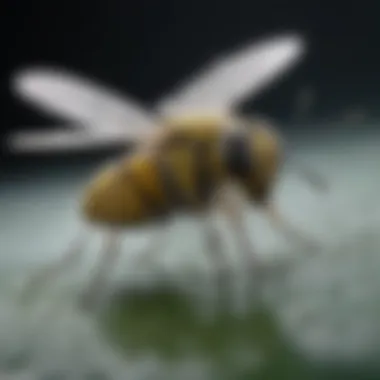
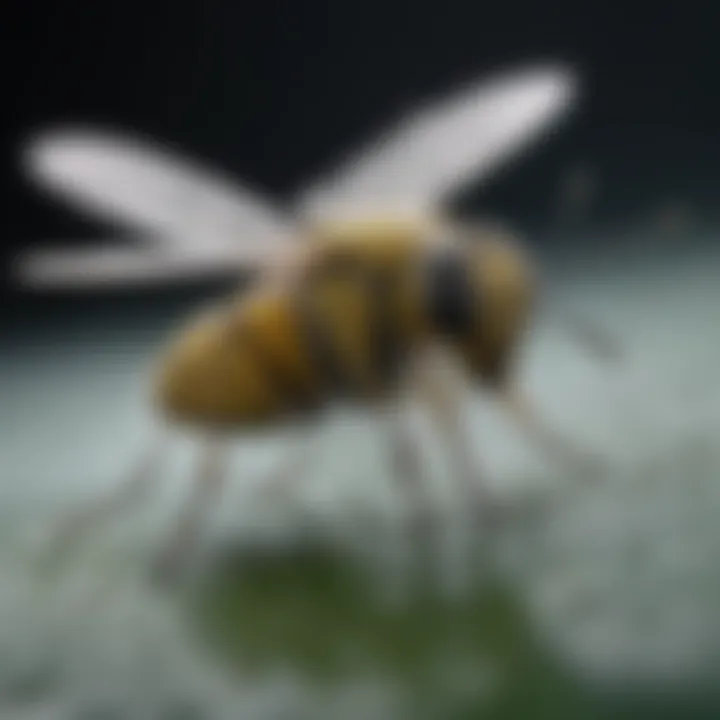
The chemistry of repellents involves a sophisticated interplay between molecular structures and biological interactions. Many commercial repellents are formulated with synthetic compounds that disrupt the sensory cues whiteflies rely on, making treated plants less attractive or even repellent.
- Active Ingredients: Common chemicals found in synthetic repellents include piperonyl butoxide and neem oil, which impact pest behavior at the molecular level. Natural options such as citronella and rosemary oil also serve as effective repellents, providing an organic method for controlling whitefly populations.
- Concentration Levels: The effectiveness of these chemicals often depends on their concentration. Higher concentrations can yield a more potent repellent effect but may also pose increased risks to non-target organisms.
- Formulation Techniques: Various formulations, such as emulsions and suspensions, can enhance the stability and distribution of active ingredients on plant surfaces, ensuring prolonged effects against whiteflies. When developing repellent strategies, the choice of formulation can significantly influence efficacy.
"A clear understanding of repellent chemistry not only ensures effective pest control but also minimizes harm to beneficial insects and the ecosystem as a whole."
Mechanisms of Action
The mechanisms through which repellents operate are equally nuanced, shedding light on why certain approaches work better than others. Repellents typically function in two primary ways:
- Sensory Disruption: Many repellents target the sensory organs of whiteflies, interfering with their ability to locate food sources. This disruption can cause confusion and disorientation, often leading these pests to abandon treated plants.
- Deterrence through Taste and Smell: Some compounds create an unfavorable taste or odor, effectively making the plant less palatable. This taste aversion can lead to reduced feeding and subsequent population declines.
These mechanisms also call for a careful consideration of timing and environmental conditions when applying repellents. For instance, applying a repellent during peak whitefly feeding activity could maximize its effectiveness, whereas neglecting this timing can lead to poor results.
In summary, the principles behind whitefly repellents encompass a blend of scientific understanding and practical application. Each component, from the chemical makeup to how these substances interact with pests, plays a pivotal role in successful pest management strategies.
Types of Whitefly Repellents
Understanding the various types of whitefly repellents is crucial for anyone serious about pest management in agriculture. Each type offers distinct benefits and poses its own set of considerations. With the right choice, farmers can significantly reduce the damage caused by whiteflies while maintaining environmental integrity and crop health.
Synthetic Chemical Repellents
Synthetic chemical repellents have gained prominence due to their immediate effectiveness against whiteflies. These chemicals are designed to target the specific physiology of whiteflies, often disrupting their ability to feed or reproduce. Most of them work by interfering with the nervous system of the pests, causing them to vacate the treated areas.
- Examples of widely-used synthetic repellents include imidacloprid and chlorfenapyr.
- Unlike natural solutions, synthetic repellents tend to offer more potent and longer-lasting effects, making them attractive for large-scale agricultural operations.
- However, the downside is their potential for creating resistance in whitefly populations. Over time, continued reliance on these substances can lead to situations where whiteflies do not respond as effectively to treatments.
Key considerations:
- Monitor application rates closely to avoid resistance.
- Always follow safety regulations and usage guidelines to minimize risks to non-target species.
- Be mindful of ecological impact, as runoff can affect nearby soil and water quality.
Natural Plant-Based Solutions
Natural plant-based solutions have garnered attention as sustainable alternatives to synthetic chemicals. These repellents often derive from the defensive chemicals in plants that evolved to deter pests.
Some common natural repellents include:
- Neem oil: Extracted from the seeds of the neem tree, it disrupts whitefly feeding and reproductive cycles.
- Garlic extract: Known for its strong odor, it can mask the scents that attract whiteflies to crops.
- Essential oils such as peppermint or clove, both of which have shown promising results in deterring various pests including whiteflies.
The most significant advantage of these natural options is their lower toxicity to beneficial organisms. This characteristic makes them preferable in integrated pest management strategies.
However, while natural repellents can be effective, they often require more frequent applications compared to synthetic options. This is due to their shorter residual effects, which can lead to increased labor and costs if not managed well.
Biological Control Agents
Biological control agents are organisms that naturally inhibit whitefly populations. These include predatory insects, parasitoids, and pathogens, and are typically part of a balanced ecosystem.
- Predatory insects like Encarsia formosa, a tiny wasp, lay eggs inside whiteflies, effectively reducing their numbers.
- Entomopathogenic fungi can also infect and kill whiteflies, providing a natural means of population control.
By using biological control methods, farmers can reduce their dependence on chemical pesticides, leading to healthier ecosystems. The integration of these natural enemies into agricultural systems promotes biodiversity and resilience against pests in the long run.
However, relying solely on biological control can be uncertain; it often takes time for populations of natural enemies to establish, and immediate results may not be visible. For best success, it is advisable to combine biological agents with other types of repellents in an integrated pest management system.
Evaluating Efficacy
To grasp the real-world impact of whitefly repellents, it’s crucial to evaluate their efficacy—how well they accomplish their intended purpose. This evaluation tends to encompass a feast of factors, including but not limited to performance in various environments, the frequency of application, and the specific whitefly species targeted. Understanding the efficacy helps horticulturists and agricultural professionals make informed decisions, ultimately saving time and resources while protecting crops from these pesky pests.
Evaluating efficacy isn’t just a box-checking exercise; it's a foundational component that optimizes pest management strategies. Knowing how well a repellent works helps in determining its cost-effectiveness, guiding farmers towards choices that will yield substantial benefits. It's also pivotal in framing future research, directing attention to the types of formulations that show promise against resistant whitefly populations.
"The success of pest control depends not just on the choice of repellent, but on how its efficacy is assessed in real operational contexts."
Field Studies on Repellent Performance
Field studies serve as the cornerstone for assessing how repellents perform under actual conditions. In these studies, researchers deploy different repellent formulations across varying landscapes—think both agricultural fields and diversified ecosystems—to evaluate their effectiveness against whitefly infestations. Some common metrics include:
- Reduction in Whitefly Populations: Observations are made to note how many whiteflies remain after applying treatments compared to untreated areas.
- Crop Health Assessment: Evaluating plants’ vigor, yield, and overall resilience post-application provides insight into the repellent’s impact.
- Longevity of Effectiveness: Researchers often look into how long a repellent continues to deter pests after application.
These studies frequently leverage observational techniques alongside quantitative data. Advanced methods, like utilizing sticky traps, allow for direct measurement of insect populations before and after the introduction of repellents. Moreover, collaborations with farmers are vital, as their firsthand experiences yield invaluable feedback that can shape future applications of these findings.
Laboratory Assessments
While field studies shine a light on real-world performance, laboratory assessments provide a controlled environment to dissect the finer details of whitefly repellent efficacy. In labs, scientists can isolate variables much more effectively, allowing them to focus on aspects such as:
- Active Ingredients Analysis: By testing different concentrations of active ingredients, researchers can pinpoint the optimal formulation for repellent action.
- Behavioral Studies: Observations on whitefly behavior in response to various repellents can yield crucial insights into how substances interfere with their attraction to plants.
- Toxicity Measurements: Laboratory settings allow for the careful evaluation of potential toxic effects on the whiteflies and neighboring beneficial insects.
One methodology might involve bioassays, where cohorts of whiteflies are placed in environments with either treated or untreated plants. Monitoring their movement, feeding, and reproduction can inform on both short-term deterrence and longer-term population implications.
Both field studies and laboratory assessments are vital for a holistic understanding of whitefly repellent efficacy. Combining insights from these two domains empowers decision-makers with the knowledge they need to tackle the challenges posed by whiteflies effectively. The rigorous evaluation of repellents not only leads to better pest management practices but enhances the sustainability of agricultural systems.
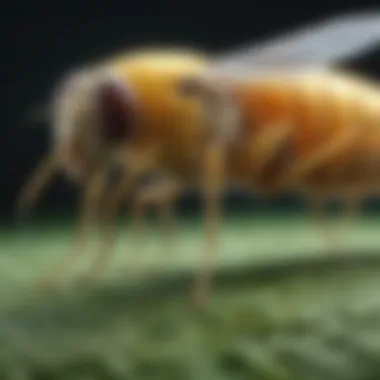
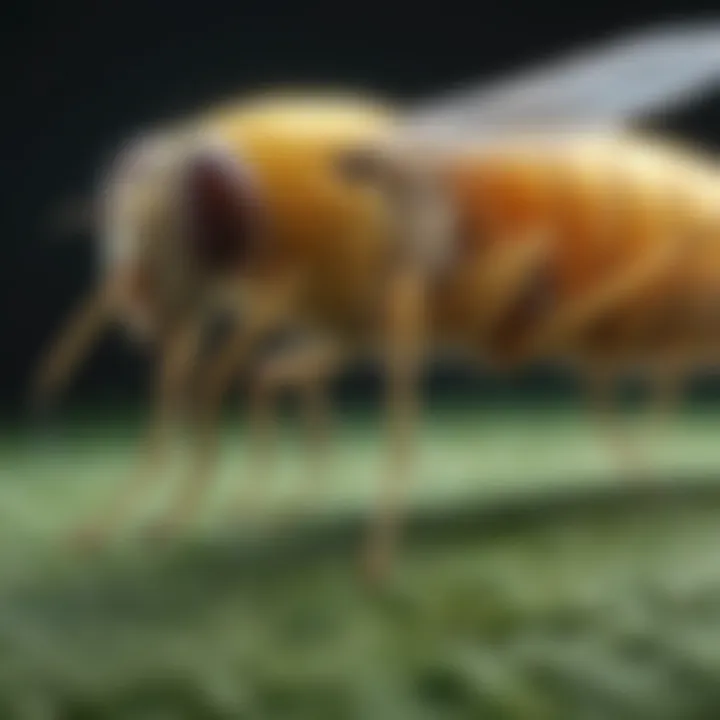
Application Techniques
Understanding the techniques for applying whitefly repellents is crucial. How these repellents are delivered can significantly influence their effectiveness and the overall health of crops. Proper application reduces waste and maximizes impact, which is why it’s a core focus of this article.
The effectiveness of whitefly repellents can hinge on several factors associated with application methods. It’s not just about spraying the chemical or solution randomly. Factors such as the time of day, the weather conditions, and the specific method of delivery can make a huge difference.
When we consider the benefits, a well-planned application technique can lead to:
- Improved Efficacy: Ensures that repellents reach the target areas where whiteflies congregate.
- Cost Efficiency: Reduces the amount of product needed, thus lowering expenses for farmers.
- Reduced Environmental Impact: Better targeting can minimize the effect on non-target species and soil health.
In summary, the right application techniques maintain high standards of pest control while keeping environmental concerns in check. This section delves deeper into the methods to achieve successful applications.
Spraying Methods
Spraying methods come in various forms, and understanding each type can help in making a wise choice depending on the situation at hand. Here are a few commonly used methods:
- Backpack Sprayers: These tools allow for a hands-on approach. Farmers can get into tricky spots that might be hard to reach otherwise.
- Aerial Spraying: For larger fields, planes or drones can cover vast areas quickly, ensuring uniform application.
- Tractor-Mounted Sprayers: Ideal for extensive farming operations, these systems can handle high volumes of solution and cover more ground.
- Handheld Sprayers: Useful for quick applications in small areas, often used in nurseries or gardens.
Each method has its advantages and potential drawbacks. For example, while aerial spraying can cover large areas, it may lead to drift, affecting nearby plants. In contrast, handheld sprayers provide precision but might require significant labor input.
Consideration also needs to be given to the spray material—whether it’s liquid or granular—and the pressure settings during application. For instance, higher pressure may disperse the droplets more evenly but can also lead to increased drift.
Timing and Frequency of Application
Timing is everything when it comes to whitefly control. Knowing precisely when to apply repellents can make or break their effectiveness. The prime time for application often focuses on periods of high whitefly activity. Analyzing patterns in population peaks can guide farmers on optimal timing to strike.
Factors to consider include:
- Life Cycle Stage: Targeting specific life stages (like the nymphs) can enhance effectiveness as they may be more vulnerable.
- Weather Conditions: Rain can wash away treatments, while wind can impede application accuracy. Early morning or late afternoon often offers calmer conditions.
- Seasonal Changes: As seasons shift, so do whitefly behaviors. Adjusting frequency according to seasonal dynamics ensures ongoing protection.
It’s also essential to space out applications appropriately. Over-application can lead to resistance among pest populations and may harm beneficial insects in the ecosystem. A rotation of methods, alternating natural and synthetic options, can keep pests off balance and minimize the likelihood of resistance.
"Effective pest management needs to consider not just when but how often to apply treatments to see real results."
By integrating these techniques, farmers can develop a robust strategy that is both adaptive and effective in managing whitefly populations.
Environmental Considerations
Understanding the environmental implications of whitefly repellents is crucial. This segment outlines what we should keep in mind when selecting and using these products, balancing the necessity of pest control with the preservation of ecosystems. Start of the show are the non-target species that might be affected, as well as the residues left behind that can impact soil health.
Impact on Non-Target Species
When we consider the use of whitefly repellents, it's not just the intended pests that come to mind. Non-target species, including beneficial insects like bees and ladybugs, can also be significantly influenced. The potential for collateral damage in ecosystems can be substantial.
- Specific Concerns:
- Besides whiteflies, many repellents may accidentally harm insects that pollinate crops or assist in natural pest control.
- Certain synthetic chemicals could disrupt the life cycles of these species, ultimately affecting biodiversity.
Taking this into account, it becomes essential to choose repellents wisely. Integrated Pest Management (IPM) strategies often advocate for solutions that ensure maximum effect on target pests while minimizing harm to beneficial creatures. The use of selective repellents that specifically target whiteflies can go a long way in preserving the delicate balance of our ecosystems.
Residue and Soil Health
The residues left after applying whitefly repellents can have serious ramifications for soil quality and health. This concern is often overlooked in discussions about pest management. The residual chemicals can seep into the soil, affecting not only the immediate area but also the wider environment.
- Key Points to Consider:
- Degradation of Soil Microorganisms: Many of these chemicals can be toxic to soil microflora and fauna, which are integral to maintaining soil fertility and health.
- Accumulation Effects: Repeated use of certain repellents may lead to a buildup of toxic substances in the soil, further exacerbating ecological damage over time.
- Bioavailability: Some residues can alter nutrient availability, impacting how crops take up essential minerals and nutrients.
To mitigate these issues, it’s advisable for farmers and land managers to implement practices that help reduce residual impacts. This involves understanding the degradation pathways of chemicals applied and promoting organic matter addition to sequester or break down these residues.
"Adopting a holistic approach to pest management takes into account the complexities of natural ecosystems, reminding us that everything is intertwined in the web of life.”
In summary, while the battle against whiteflies is necessary to ensure healthy crops, it's imperative to do so with a vigilant eye toward environmental sustainability. This includes being educated on the potential side effects of repellent choices and striving for methods that uphold the health of both soil and surrounding species.
Economic Implications
Understanding the economic implications of whitefly repellents is crucial for both farmers and the agricultural industry as a whole. The impact of these repellents extends beyond simple pest control, encompassing broader financial considerations that play a significant role in agricultural sustainability and profitability. Evaluating the economic aspects enables stakeholders to make informed decisions that can significantly affect crop yield, resource allocation, and overall farm management practices.
In numerous farming contexts, the cost of inaction in the face of whitefly infestation can lead to severe economic repercussions. Whiteflies can wreak havoc on a variety of crops, leading to diminished yield quality and quantity. Thus, the necessity of effective whitefly repellents cannot be overstated. The economic implications naturally unfold into several key areas, including the cost-benefit analysis of their usage and emerging market trends that shape the industry.
Cost-Benefit Analysis of Usage
When examining whitefly repellents, a detailed cost-benefit analysis emerges as a central theme. Farmers often grapple with the decision to invest in chemical versus natural repellents, weighing initial costs against potential losses from pest damage. Consider the following aspects:
- Initial Investment: This entails purchasing the repellent itself, whether it be synthetic or natural. On the surface, synthetic options may appear more cost-effective due to their potency.
- Indirect Costs: These include possible losses from decreased crop yields or the expenses associated with additional pest management strategies that may be required if repellents fail to perform as expected.
- Long-Term Savings: Natural solutions may have a higher upfront cost but could result in less environmental damage and long-term sustainability, potentially improving soil health over time.
Conducting a comprehensive cost-benefit analysis can expose the trade-offs between immediate financial outlays and the long-lasting economic health of farming operations. This layered subtleness is where critical decision-making happens. Farmers must navigate these waters wisely, balancing profitability with sustainability.


Market Trends in Repellent Products
Examining market trends provides further insights into the economic implications tied to whitefly repellents. The evolving landscape of agricultural practices is shaped by both regulatory measures and consumer preferences, creating a shift in demand for various repellent types. Key trends include:
- Growing Demand for Natural Products: Farmers and consumers alike are becoming increasingly aware of environmental impacts, leading to a surge in demand for eco-friendly, plant-based repellents. This preference creates an opportunity for development in this niche market.
- Sustainability Regulations: As governments push for sustainable agricultural practices, products that align with these mandates often receive favorable reception and support from both private and public institutions. The financial incentive for farmers to adopt sustainable practices cannot be ignored.
- Innovation in Repellent Formulations: There is an uptick in research and development aimed at improving the efficacy, convenience, and safety of whitefly repellents. New formulations can command premium pricing, indicating a shift in market dynamics and profitability.
To summarize, understanding the economic implications tied to whitefly repellents highlights not just the worth of these products but also the broader financial ecosystem they inhabit. By focusing on cost-benefit dynamics and evolving market trends, stakeholders can make strides toward more effective pest management strategies that serve both economic and environmental interests.
"Evaluating the economic effects of pest repellents not only assists in immediate financial decisions but also aids in crafting long-term sustainable farming practices."
Through a meticulous overview of these implications, individuals in agricultural sectors can enhance resilience against whitefly-related economic challenges.
Recent Advances in Research
Recent advancements in the study of whitefly repellents hold immense significance in the agricultural sector, primarily due to the ongoing challenges posed by whitefly infestations. As these pests continue to threaten crops globally, research efforts are focusing on developing more effective and sustainable repellent options. Understanding the urgency behind these innovations is essential for both farmers looking to protect their yields and researchers aiming to push the boundaries of pest management science.
The exploration of cutting-edge repellent formulations illustrates the commitment to environmental sustainability and the quest for enhanced efficacy. Innovations often arise from interdisciplinary approaches, melding chemistry with biology, which helps create repellents that are not only efficient but also safe for the ecosystem. This alignment with sustainable practices enhances the appeal of recent research to a broader audience, particularly in light of increasing demand for organic farming methods.
Moreover, staying abreast of these developments allows stakeholders to adapt to market shifts and regulations that favor eco-friendly solutions.
Innovations in Repellent Formulations
Innovative repellent formulations are shaping the landscape of pest control. A key focus lies in the synthesis of compounds that mimic natural deterrents found in various plants. These formulations often utilize essential oils, such as peppermint and neem, known for their ability to repel whiteflies effectively. Researchers have started exploiting the synergistic properties of these oils, developing blends that enhance their overall effectiveness while minimizing toxicity.
- Hybrid Formulations: One notable advancement includes hybrid products that combine both synthetic and natural elements. This fusion aims to harness the strengths of each component, thus prolonging the active duration of repellents while ensuring a minimal negative impact on beneficial insects. Such strategies might include a base of naturally derived oils augmented with synthetic enhancers.
- Nano-encapsulation Technologies: Another significant area of innovation involves the use of nano-encapsulation technologies. This method involves enveloping repellent compounds in carrier materials on the nanoscale, allowing for controlled release over time. By targeting necessary areas of the plant, these products can reduce the number of applications needed, which, in turn, saves labor hours and minimizes environmental load.
Such advancements are crucial, especially as they promise to improve the longevity and effectiveness of repellents, which is essential in the fight against resilient whitefly populations.
Studies on Resistance Management
The ongoing battle with whitefly infestations has underscored the need for comprehensive studies on resistance management. Resistance to common whitefly repellents can emerge swiftly, particularly when these pests are exposed continuously to the same chemical agents. This scenario necessitates research that focuses on both understanding the mechanisms of resistance and developing strategies to mitigate its impact.
One approach involves rotating different classes of repellents, thus reducing the likelihood of resistance buildup in target populations.
- Diverse Repellent Usage: Studies emphasize the importance of employing a varied arsenal of repellents—both chemical and biological. By integrating multiple repellent strategies, farmers can keep pests guessing, thereby hindering their adaptation. The cycle of using diverse active ingredients can disrupt the potential resistance pathways.
- Monitoring and Data Analysis: Another pivotal area of research involves the systematic monitoring of pest populations to identify signs of resistance early. Data analytics enables researchers and farmers to draw actionable insights from population trends, informing timely interventions that target susceptible groups of whiteflies.
Above all, these studies not only aim to preserve the effectiveness of current repellents but also contribute to a more sustainable and integrated approach to pest management. By addressing the challenge of resistance proactively, agricultural stakeholders can secure crop health well into the future.
Best Practices for Farmers
In the battle against whiteflies, farmers hold the frontline defense. Implementing effective practices not only enhances crop health but also sustains the ecosystems surrounding agricultural lands. This section explores tailored strategies that can effectively manage whitefly populations while promoting sustainable and productive farming practices.
Integrative Pest Management Approaches
Integrative Pest Management (IPM) stands as a holistic approach to pest control, blending multiple strategies to curb whitefly infestations. The emphasis here is on ecological balance and sustainable farming, which is crucial for minimizing reliance on chemical repellents.
- Cultural Controls: This involves planting resistant varieties or timing planting to avoid peak whitefly activity. Crop rotation, intercropping, and maintaining healthy soil can deter these pests.
- Biological Controls: Introducing natural predators, such as ladybugs or parasitic wasps, can naturally suppress whitefly populations. Research indicates that these beneficial insects can provide a significant level of control without harming crops.
- Chemical Controls: While synthetic repellents can be effective, their integrated use with other methods reduces overall reliance. The key is to choose targeted insecticides that are least harmful to beneficial species and the environment.
- Monitoring and Thresholds: Recognizing the economic threshold of pest density helps in making informed decisions. Farmers should consider factors like growth stage, local climate, and natural enemy activity before taking action.
"The goal is to prevent whitefly outbreaks before they escalate, maintaining both yield and biodiversity."
Monitoring Whitefly Populations
Ongoing monitoring is crucial for effective whitefly management. Farmers are encouraged to establish systems that allow for the early detection of whitefly populations. This can include using sticky traps, visual inspections, or even digital monitoring tools.
- Sticky Traps: Bright yellow sticky traps attract whiteflies, giving a clear indication of population levels. Regular checks provide insight into fluctuations and help decide whether intervention is necessary.
- Scouting Techniques: Regular field scouting should become a standard practice. Observing plants for any signs of infestation, such as yellowing leaves or visible whiteflies, is essential.
- Data Recording: Keeping detailed records of whitefly sightings supports better pest management decisions. Analyzing trends over time can lead to strategic adjustments in farming practices.
To conclude, fostering an environment that combines cultural, biological, and chemical methods allows farmers to manage whiteflies effectively. Monitoring these populations diligently will not only protect their crops but also contribute to a healthier agroecosystem.
Policy and Regulation
Regulation surrounding the use of whitefly repellents is a vital aspect often overlooked in pest management discussions. It serves as the backbone for ensuring that these repellents are not only effective but also safe for use in agricultural environments. The growing awareness of environmental issues and the impacts of chemical usage on ecosystems has led to stricter policies and guidelines. As we dive into the intricacies of legislation affecting these repellents, we will note that effective policy not only protects crops but also maintains the balance of local ecosystems.
One of the most notable concerns is the potential for chemical residues to adversely affect non-target species. Hence, legislation often emphasizes risks associated with synthetic chemicals, leading to increased scrutiny of their development and application. The balance lies in protecting agricultural interests while also safeguarding biodiversity.
Legislation Affecting Use of Repellents
Legislative frameworks vary significantly by country, often reflecting the local agricultural practices and environmental priorities. For instance, in the United States, the Environmental Protection Agency (EPA) plays a crucial role in evaluating the safety and efficacy of pesticide products before they can be marketed, including whitefly repellents. This involves rigorous testing for potential health risks to humans and wildlife, along with assessments of environmental impact.
Moreover, regulations stipulate specific guidelines on the use of these repellents. Farmers must comply with application timing, dosage, and methods to minimize off-target effects. Failures to adhere to these guidelines can lead to penalties, not to mention harm to crops and ecosystems. Key aspects of such legislation often include:
- Registration Process: All new repellents must undergo extensive review, considering efficacy and safety.
- Labeling Requirements: Clear instructions and safety information must be provided on product labels to facilitate proper use.
- Monitoring and Reporting: Post-application monitoring is frequently mandated to assess the long-term impacts of repellents on ecosystems.
While these regulations may seem burdensome at times, they ensure that whitefly management practices pivot towards safer and more sustainable farming techniques.
Guidelines for Sustainable Practices
Sustainability in agriculture can no longer be an afterthought, especially when devising strategies to combat whitefly populations. Effective guidelines not only promote the use of safe repellents but also urge practitioners to adopt a holistic approach to pest management. Some guiding principles for sustainable practices include:
- Integrated Pest Management (IPM): This approach combines biological control, habitat manipulation, and the judicious use of repellents to optimize agricultural outcomes while minimizing ecological harm.
- Natural Alternatives: Utilizing naturally derived repellents often aligns better with sustainability goals, leading to a reduced risk of adverse effects on non-target species.
- Continuous Education: Farmers need to stay informed about new research findings and methods concerning whitefly control to adapt their practices effectively.
Additionally, organizations and governments should actively provide resources and support for farmers to transition to sustainable strategies. This can manifest in the form of workshops, subsidized training programs, and access to research findings.
In closing, effective policy and regulation, coupled with robust guidelines for sustainable practices, are the cornerstone of successful whitefly management. They offer a structured approach that respects not only agricultural productivity but the intricate ecosystems in which these practices take place.



